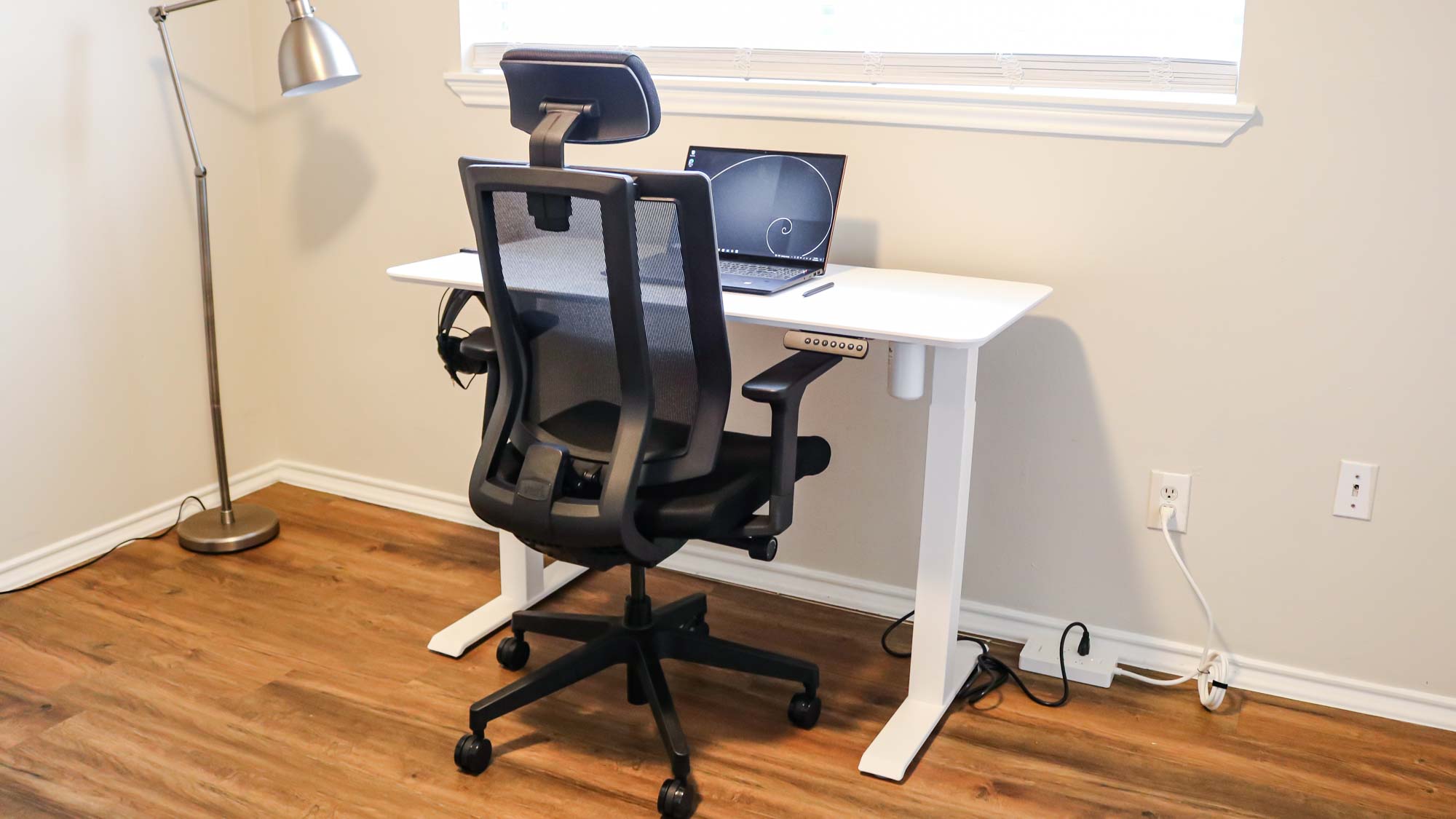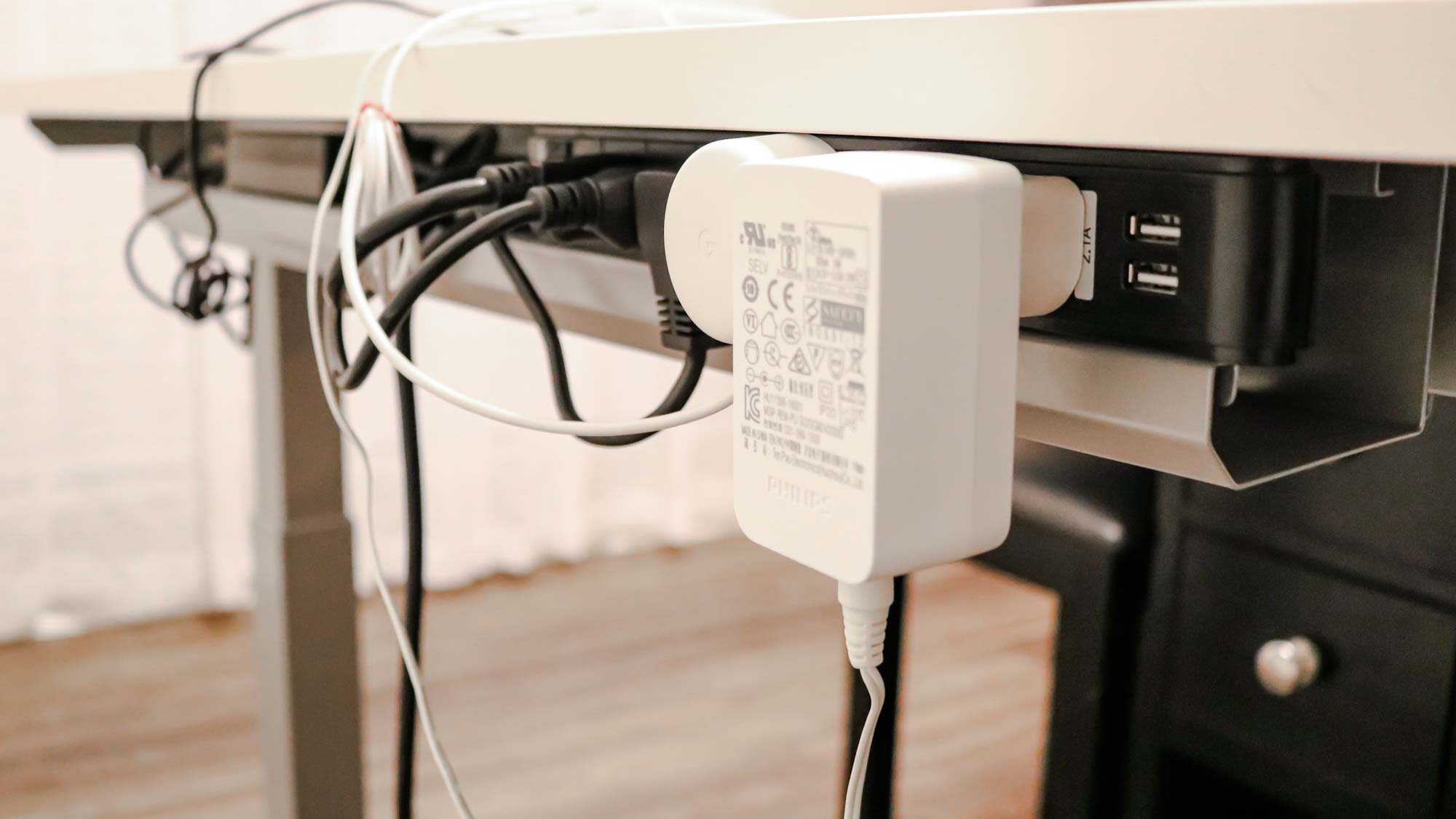I spent a year reviewing standing desks — and this is the one accessory I can’t live without
Make full use of your new standing desk with a cable management tray

Whether you’re starting a new work from home job or heading back to school this fall, one of the best standing desks can help you stay more active and could even boost your productivity. However, after building and reviewing almost a dozen myself in the past year alone, there’s one accessory that I wholeheartedly recommend to improve your experience.
Regardless of which standing desk you choose, you’ll be using other electronic devices with it. Even if you’re primarily a laptop user, you’ll still want to plug in your computer to keep it charged. Likewise, desktop PCs also require power as do your monitor, speakers and other desk accessories.
This is why a cable management tray is the one accessory you shouldn’t overlook if you’re thinking about making the upgrade to a standing desk yourself.
Desktop or laptop – you still need a cable management tray
You may be wondering why I think a cable management tray is an essential accessory if you plan on using your standing desk with only a laptop. Well the reason is simple: the power bricks that ship with most laptops just don’t have a long enough cord to comfortably move with your desk as you raise and lower its height.

Back when I reviewed the MSI Summit E16 Flip 2-in-1 laptop during my time at TechRadar Pro, I tested it out using the Vari Essential Electric Standing Desk which unfortunately, isn’t available with a cable management tray. When using the desk while standing with the laptop plugged into the wall, I had to prop up its power brick underneath the desk as I didn’t want it hanging in the air to avoid damage.
Sure, you can charge your laptop somewhere else and use it on your standing desk running off of battery but isn’t it better to be able to charge your devices where you actually plan on using them?
Fortunately, I found a cable management tray from a brand called Scandinavian Hub on Amazon for $40 that can be mounted to the top of the Vari Essential Electric Standing Desk (as well as the FlexiSpot EG8 Comhar).
Although a cable management tray can be quite useful for laptop users, having one is an absolute necessity if you plan on using your standing desk with a desktop PC. The beauty of a cable management tray attached to the underside of your desk is the fact that you can place a surge protector there and have all of your devices plugged in to it. This way, everything stays powered on when your desk is lowered or raised without having to worry about something coming unplugged.
Not all cable management trays are created equally

Now that you know the importance of a cable management tray, it’s time to choose one to go with your new standing desk.
From my own experience, FlexiSpot, Uplift Desk, ApexDesk, Vari and even Ikea all sell their own cable management trays. While you’ll normally have to pay extra for one, UpliftDesk is the only company I know of that includes one for free with its Uplift V2; it’s plastic but still quite sturdy. Still though, both first-party as well as third-party cable management trays typically cost around $30 but you’ll also want to get a surge protector with a cable that’s long enough to move up and down with your desk.

When reviewing the ApexDesk Elite Series 60, I was thoroughly impressed with the depth, length and extra features of the company’s cable management tray. In addition to plastic brackets to keep your cords tidy, there are also holes at either end and in the middle through which you can run the power cable of your surge protector. This allows you to plug it in regardless of whether the closest power outlet is on the left or right side of your home office or wherever else you plan on setting up your standing desk.

Although there isn’t a cable management tray available for its Essential standing desk, Vari does sell one for its flagship Electric Standing Desk. It’s a bit more expensive, but in addition to holes at either end, it can tilt back and forth to make it easy to plug in new devices without having to move your desk away from the wall.
You can always add your own cable management tray

Even if the company you’re buying a standing desk from doesn’t offer its own cable management tray, it’s easy to add your own, granted your desk has a wooden desktop. You will need to drill pilot holes first though and a set of extra long drill bits will make the job much easier.

As some of the desks I’ve reviewed didn’t come with a cable management tray or there wasn’t one available, I often had to improvise as I’m primarily a desktop user. Since I found myself reviewing multiple standing desks at the same time, I purchased this two pack of cable management trays from a brand called KASOLUTION on Amazon for just under $40. Besides being made of metal and having a white color to match many of the desks I reviewed (you’ll definitely want a cable management tray that’s the same color as your desk), they also have large holes at either end for running cables and the company throws in a few cable management accessories free of charge.
With the cable management tray I mentioned earlier from Scandinavian Hub, it’s the perfect solution for glass desks or ones with a plastic frame that you can’t easily drill into. Instead, you simply hang it from the back of your desk and use the provided adhesive strips to hold it in place. However, it does have holes for those that would prefer (and are able to) mount it directly to their desk.
Besides powering your devices that require an AC outlet, you can also get surge protectors with USB ports to power other accessories like a lightstrip. For instance, on my main desk where I’m writing this article, I have a pair of Audioengine A2+ speakers on either end of my monitor connected to my PC using USB. However, as I didn’t want their AUX port to go unused, I have a Chromecast Audio connected to them that’s powered using one of the USB ports from my surge protector.
Clear of clutter and cables

By attaching a cable management tray to the underside of your standing desk and outfitting it with a surge protector, you can have all your devices plugged in and rest easy knowing they won’t come unplugged as you shift from a seated position to a standing one throughout your day.
This also keeps your workspace neat and organized without cables going every which way. However, one of my favorite things to use them for is actually running cables. Have a desktop PC that needs to connect to your monitor? You can run the cables from the back of your computer off your desk, tuck them neatly behind your surge protector and have them emerge on the other side and connect to your monitor.
The last advantage of using a cable management tray with your standing desk is that all of the electronics on your desk move together as one cohesive unit with only a single cable running to the nearest outlet. This allows you to easily pull your desk out when you need to rearrange or tweak your setup.
Even if you’re not using a standing desk, a cable management tray can be an excellent investment for use with one of the best desks, especially if you want to keep things neat and tidy.
Next: This $10 accessory is a life saver for keeping your cables tidy
Sign up to get the BEST of Tom's Guide direct to your inbox.
Get instant access to breaking news, the hottest reviews, great deals and helpful tips.

Anthony Spadafora is the managing editor for security and home office furniture at Tom’s Guide where he covers everything from data breaches to password managers and the best way to cover your whole home or business with Wi-Fi. He also reviews standing desks, office chairs and other home office accessories with a penchant for building desk setups. Before joining the team, Anthony wrote for ITProPortal while living in Korea and later for TechRadar Pro after moving back to the US. Based in Houston, Texas, when he’s not writing Anthony can be found tinkering with PCs and game consoles, managing cables and upgrading his smart home.
-
mormonastroscout In the article, it mentions first-party versus third-party cable management trays. Google is being no help. What is the difference between first-party and third-party cable management trays?Reply -
COLGeek First party: Provided directly by the manufacturer who made the desk.Reply
Third party: Sold by a different vendor.
